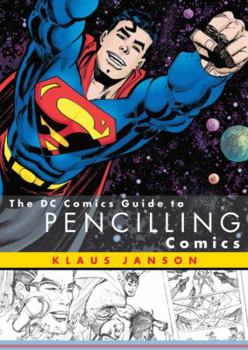The DC Comics Guide to Pencilling Comics
(Part of the DC Comics Guides Series)
Select Format
Select Condition 
Book Overview
America's leading comic book publisher brings its superstar creators and classic characters to the second in an authoritative series of books on how to create comics. The art of Klaus Janson has... This description may be from another edition of this product.
Format:Paperback
Language:English
ISBN:0823010287
ISBN13:9780823010288
Release Date:June 2001
Publisher:Watson-Guptill
Length:128 Pages
Weight:1.20 lbs.
Dimensions:0.5" x 7.3" x 9.7"
Age Range:14 to 17 years
Grade Range:Grades 9 to 12
Customer Reviews
5 ratings
GREAT ADVICE FROM A PRO
Published by Thriftbooks.com User , 17 years ago
I just received this book and immediately went to chapter fourteen. After reading chapter fourteen first I have to say that it was worth the price of the book.
Well written and inspiring
Published by Thriftbooks.com User , 18 years ago
Janson gives a well written breakdown of the techniques needed to develop into a good penciler. He discusses the finer points of story telling through the medium of illustration and uses a wide range of artists he admires as examples. It has become one of my go to books when drawing storyboards. This book, as well as his one on inking is a must for anyone seriously interested in illustration.
A solid introduction to the pencilling end of comic books
Published by Thriftbooks.com User , 21 years ago
"The DC Comics Guide to Pencilling Comics" by Klaus Janson introduces wannabee comic book artists and fans of the art form to a more detailed appreciation of what goes into drawing pages for "Batman" than they will have picked up through osmosis or imitation to date. Janson divides the fifteen chapters in this volume into three parts focusing on Drawing, Storytelling, and Pencilling designed to provide an introduction to one of the most difficult of art forms:Part One Drawing: (1) Materials outlines what supplies an artist needs in terms of paper, pencils, erasers, rulers and templates; (2) Shapes are presented as the foundation of the creative process of drawing, the general concept from which the artist moves to more specific ones; (3) Faces looks at both the basic geometric elements in composing a face and the artistic range available through example of faces drawn by Joe Kubert, Gil Kane, and Neal Adams; (4) Anatomy covers both the structure and design of the human body, including all the muscles, with special attention paid to the most difficult thing in the world to draw, the hands; (5) Clothing establishes the four basic dynamics that shape the folds and wrinkles of a person's clothing; and (6) Perspective, which is covered from the fundamentals to the use of vanishing points and systems of perspective. This unit is the most instructive in the book since it deals with the basic building blocks.Part Two Storytelling: (7) Juxtaposition establishes the uniqueness of comic book art in terms of how sequential art functions in the eyes of the reader, featuring diverse examples by Eduardo Risso, Sean Phillips, and Dave Taylor; (8) How to Lay Out a Page starts with the grid approach and then moves to the free-form end of the spectrum, starting with an example by Jack Kirby and then moving on to some by Neal Adams and Walt Simonson. Janson explains the value of insert panel and breaking borders, along with the larger pictures need for covers, splash pages, and double-page spreads; (9) Storytelling is considered as being judged by the criteria of clarity and entertainment, just like telling a joke; (10) Composition takes us down to the level of individual frames, looking at how the process of combining elements together to form a united whole; (11) Shots and Angles parallels what we know about such things from cinematography; and (12) Movement examines the one inherent disadvantage of comic art, which is trying to show movement in a static image.Part Three Pencilling: (13) Procedure lays out how most comic books are written, so you can see where the penciller comes into the process; (14) Breaking In has Janson offering advice on how to break into the business in a professional manner; and (15) Anatomy of a Story has Janson walking us through the drawing of "Good Evening, Midnight," a story he wrote and drew for "Batman Black and White" #3. "The DC Comics Guide to Pencilling Comics" provides exactly what it promises: a clear-cut introduction to t
Filled with examples from Janson's own successful work
Published by Thriftbooks.com User , 21 years ago
Aspiring cartoonists and comic artists of all ages will welcome DC Comics Guide To Pencilling Comics, an inspirational guide, penned by Klaus Janson, a comic book artist with over thirty years of experience. From creating effective and smooth visual communication sequences to learning about borders and completion processes, DC Comics Guide To Pencilling Comics is filled with examples from Janson's own successful work.
Long Overdue book from a master illustrator
Published by Thriftbooks.com User , 22 years ago
If you miss Klaus Janson's inking on Frank Miller's sequel look no futher to see his work. I have been a fan of his work since 1974. This book shows you everything you need to know about being a comic book penciler. Everything from layout to placment and composition. I hope there is a sequel. I hope that Klas has many more volumes to follow this one. It always wanted to take a course in comic book penciling and this one has it all.




